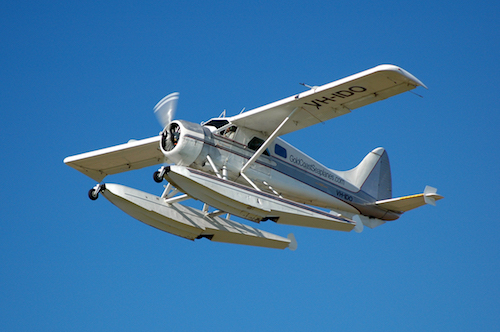Flying Module f10
Your Aircraft Specs for Module f10

(Note, this is a generic photo of a Beaver with floats, from Wikipedia. Neither this particular aircraft nor the operator are associated with the case study in this module. Photo credit:By Robert Frola - Flickr, GFDL, https://commons.wikimedia.org/w/index.php?curid=32394810.)
The De Havilland>-Canada Beaver aircraft is a light aircraft used for general aviation and for air taxi and commuter service to remote communities. It is a very popular bush plane. When equipped with floats, it is a popular floatplane in Canada. See YouTube video of a Beaver floatplane taking off.
It has a single radial 9-cylinder engine (450 hp). Typical cruise speed is about 143 knots (264 km/hour) with wheels, or 110 knots (203 km/hour) with floats. To take off, it needs a speed of about 60 to 65 knots (110-120 km/hour) relative to the air. To clear a 50 ft (15 m) obstacle, take-off distance is 1,610 ft (0.5 km). Maximum safe crosswind component for take-off is 8.7 knots (= 10 miles/hour = 16 km/hour).
It needs only one pilot (you). It holds up to 6 passengers in addition to the pilot.
Your aircraft was built in 1957. It has 4 doors, two on each side. When docked, only the left doors are used. On this flight, the aircraft is in good working order, except that you partly disabled the stall-warning alarm to make it quieter. (A stall is when the aircraft if flying so slow that the wings do not generate enough lift to keep the aircraft airborne.)
Even a song was written about Beaver aircraft.
Extra info for experts; not required for this course.
- Bushplanes.com about the Beaver.
- Wikipedia.
- Pilots Operating Handbook (POC) = Flight Manual = Instruction Manual for a slightly different model of Beaver.
- Seaplane Handbook = guidelines on how to fly a floatplane. https://www.faa.gov/regulations_policies/handbooks_manuals/aviation/seaplane_handbook/
UBC ATSC 113 - Weather for Sailing, Flying & Snow
Sports
Copyright © 2016-2018 by Roland Stull.
Last updated Aug 2018.